Green Beans with Bacon
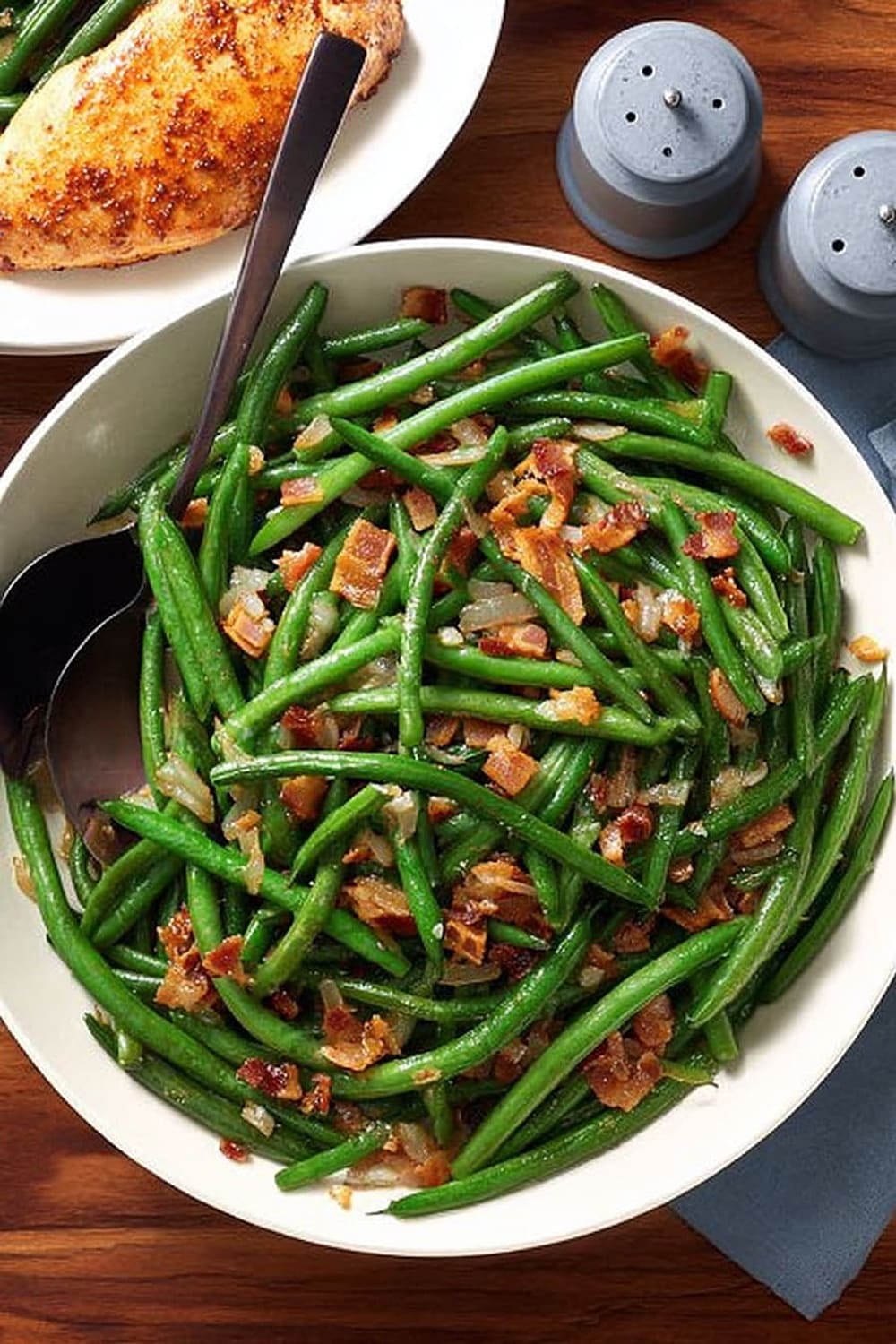
This recipe is basically the vegetable equivalent of putting on your favorite pair of jeans – comfortable, reliable, and somehow makes everything else look better.
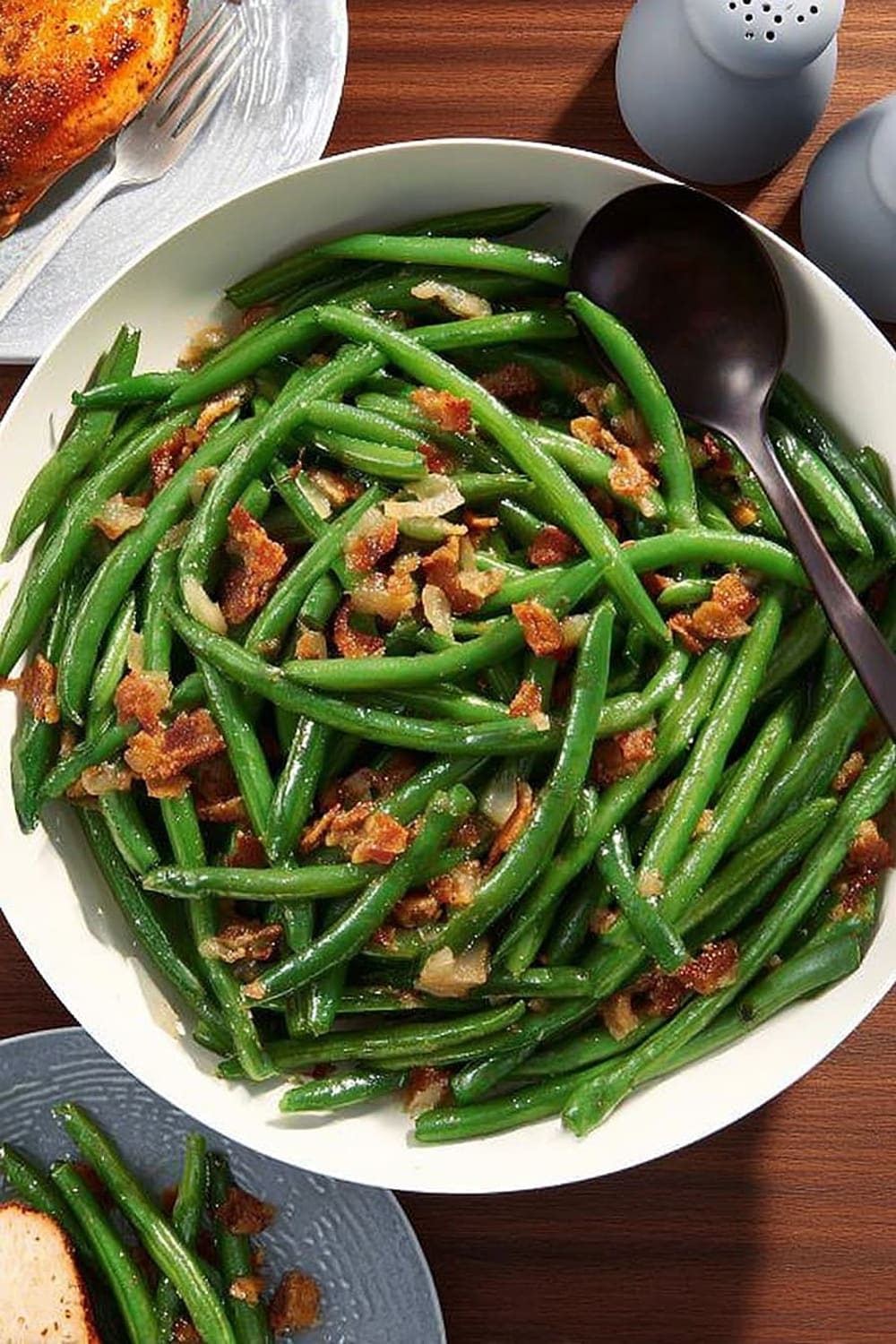
Warning: making this will result in people suddenly volunteering to help with dinner, and it’s definitely not because they want to wash dishes.
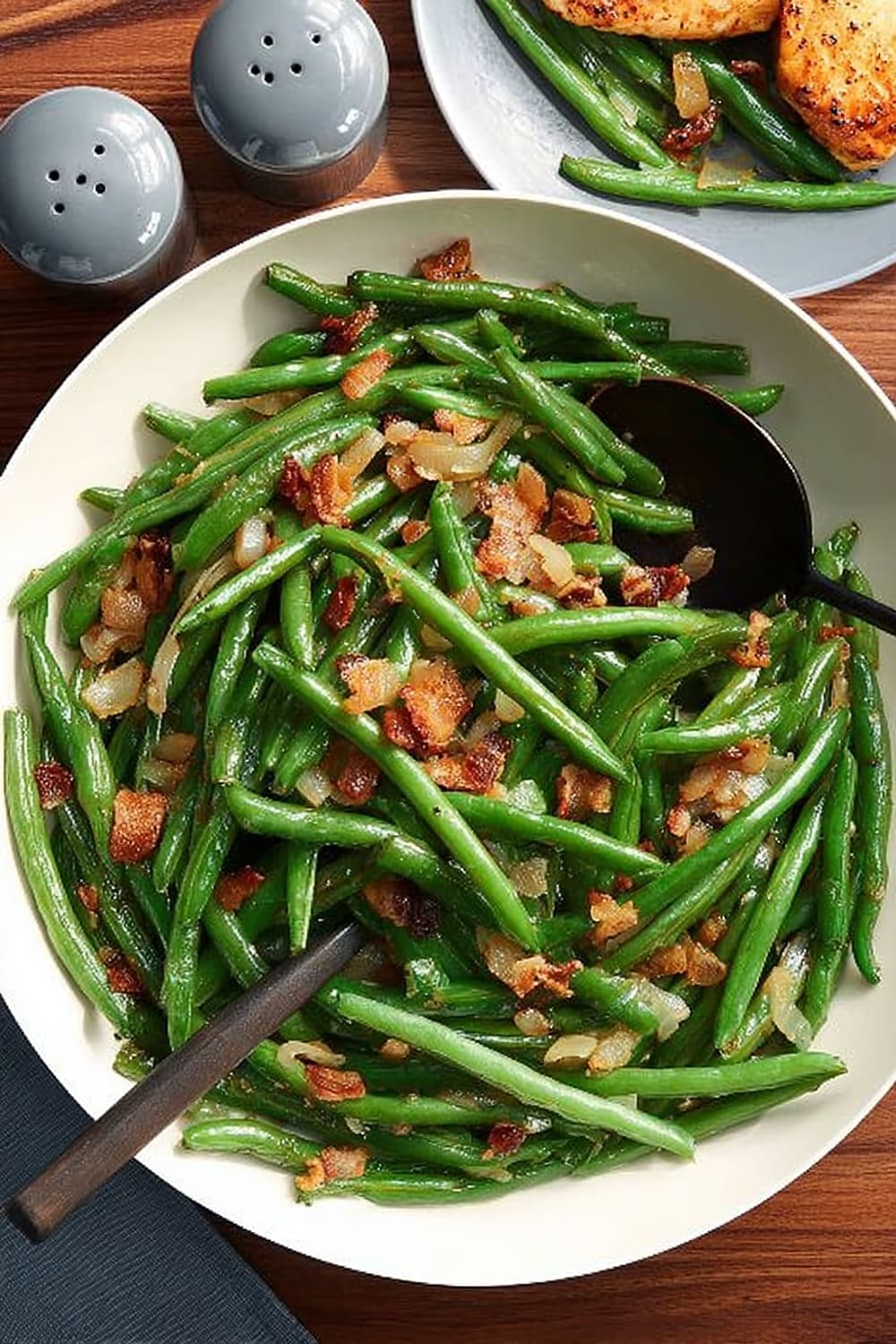
The smoky bacon fat transforms ordinary green beans into something that would make your grandmother nod approvingly while secretly wondering why she never thought of this combination.
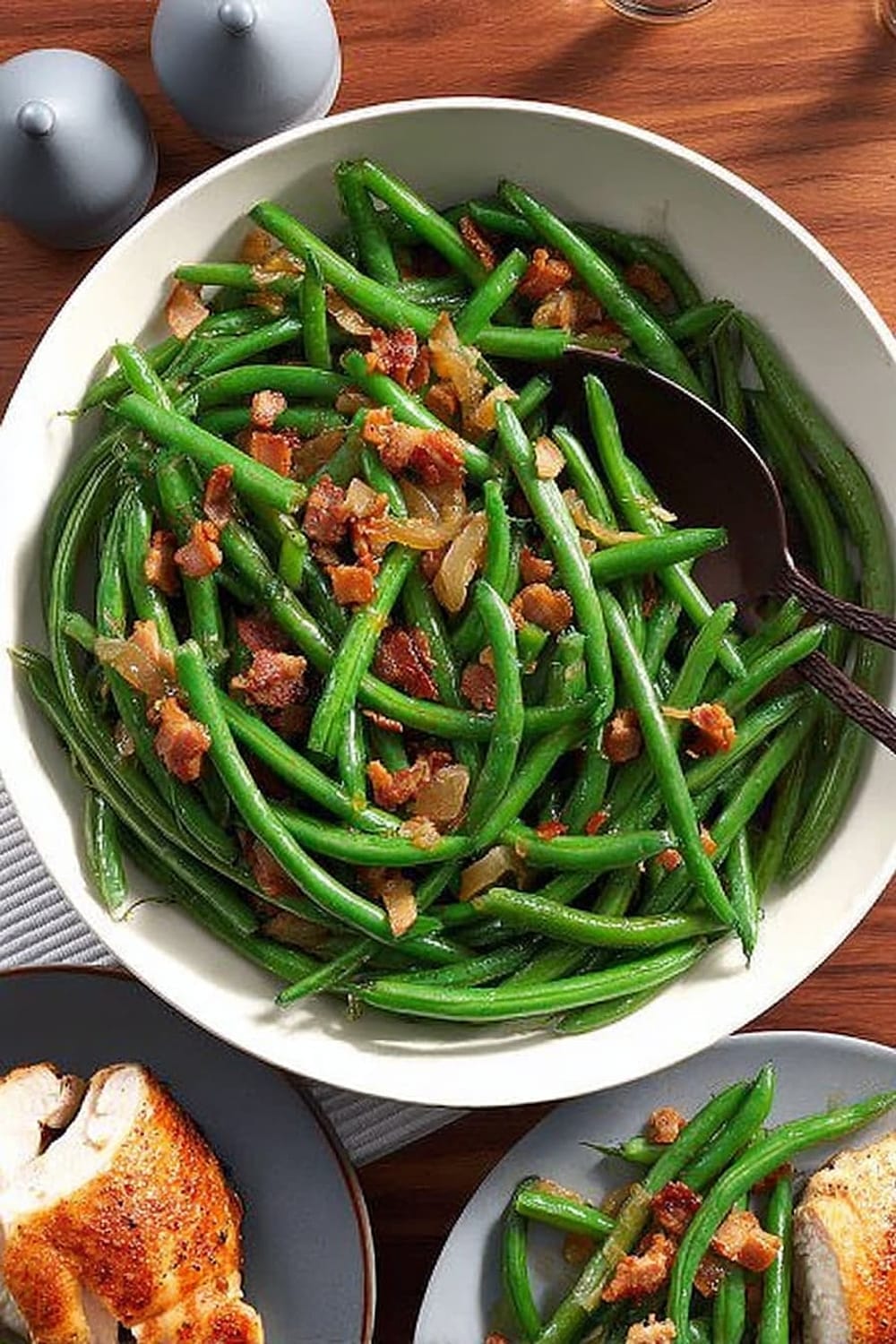
This is the kind of side dish that makes you feel like a cooking genius, even though you’re basically just throwing vegetables and bacon in a pan and calling it a day.
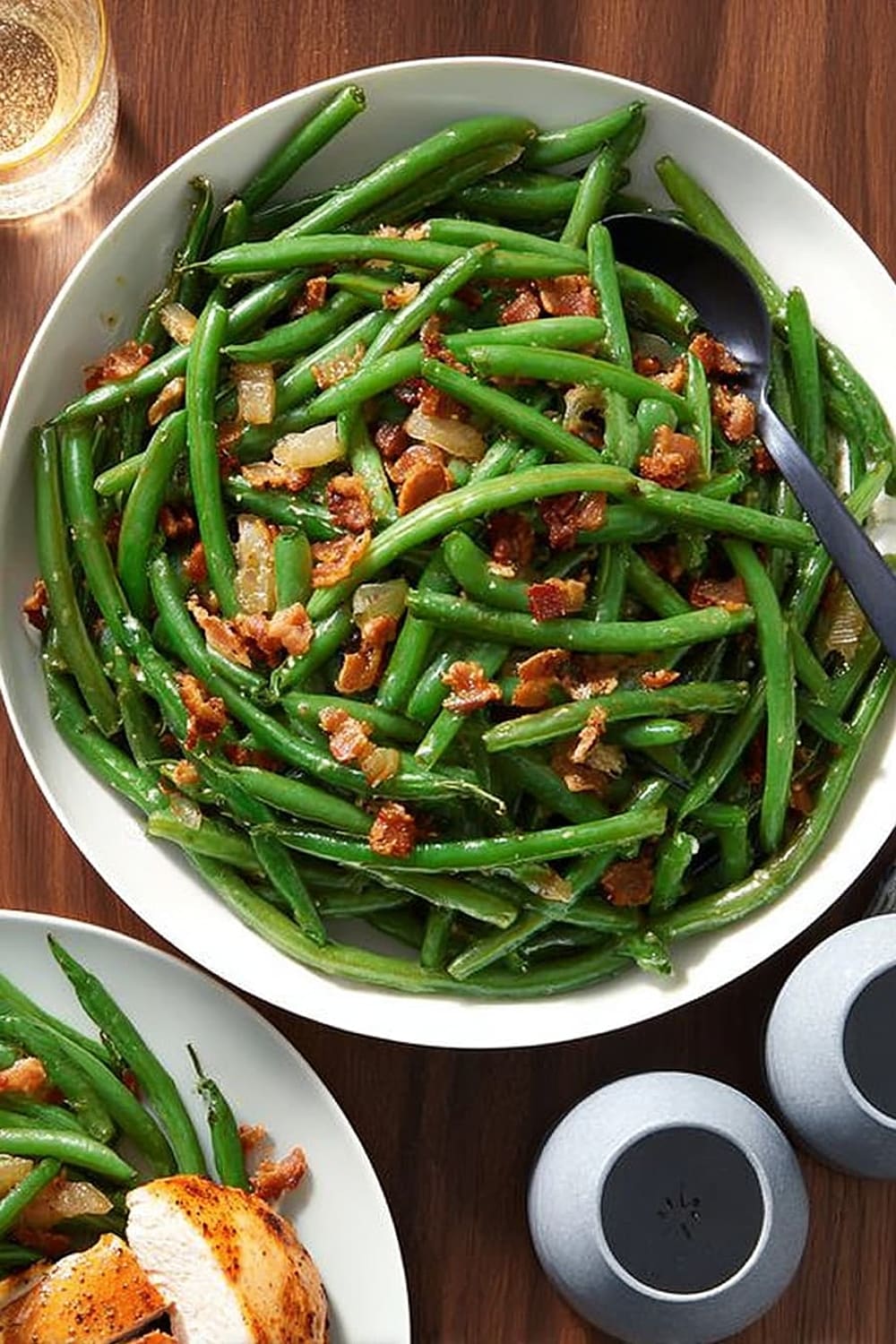
Prepare yourself for the ultimate compliment: “Wait, these are just green beans?” followed by the sound of people going back for thirds.

About to become your go-to recipe when you need something that looks intentional but requires zero stress-sweating through complicated techniques.
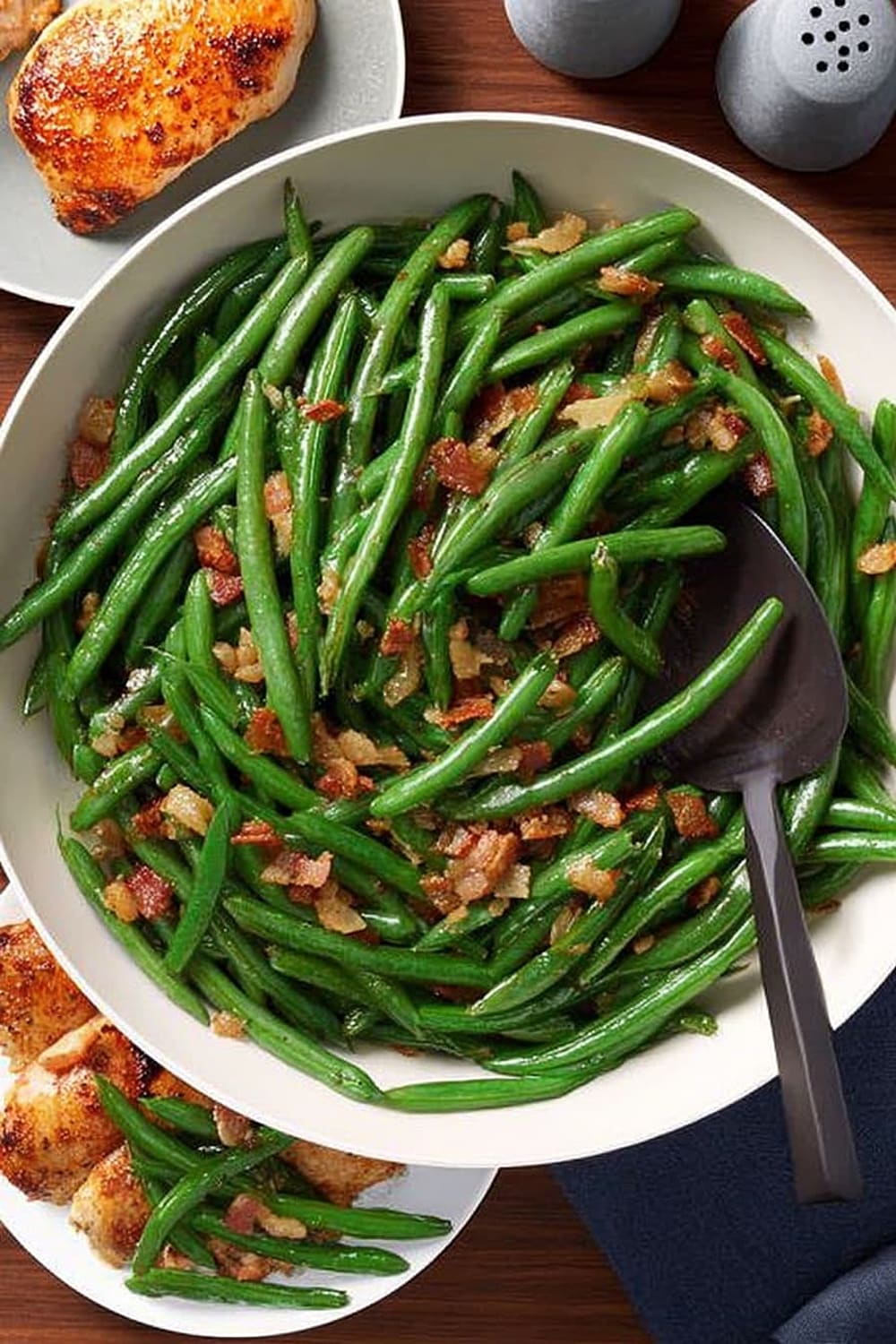
Ingredients
For the green beans
- 8 cups fresh green beans, trimmed
- Water for boiling
- 1 /4 teaspoon salt
- 1 /8 teaspoon pepper
For the bacon mixture
- 4 bacon strips, chopped
- 1 /2 cup chopped onion
Instructions
Prepare the green beans
- 1 Place 8 cups fresh green beans in a large saucepan and cover completely with water. The water should come about 2 inches above the beans to ensure even cooking and prevent scorching.
- 2 Bring the water to a rolling boil over high heat, which typically takes 5-7 minutes depending on your stovetop. You’ll know it’s ready when you see vigorous bubbling throughout the pot.
- 3 Cook the beans uncovered until they reach that perfect crisp-tender texture, about 8-10 minutes. Test doneness by piercing with a fork – they should offer slight resistance while still having a bright green color and satisfying crunch.
- 4 Drain the beans immediately in a colander and give them a gentle shake to remove excess water. This prevents the final dish from becoming watery and helps the bacon fat coat each bean properly.
Create the bacon base
- 5 In a large cast iron skillet or heavy-bottomed pan, cook the 4 chopped bacon strips and 1/2 cup chopped onion over medium heat. This moderate temperature ensures the bacon renders its fat slowly while the onion caramelizes without burning.
- 6 Stir occasionally for 3-5 minutes until the bacon reaches that perfect crispy texture and the onion becomes tender and translucent. The bacon should be golden brown and the onion should have lost its raw bite completely.
Finish and serve
- 7 Add the drained green beans to the bacon mixture in the skillet. Use tongs or a large spoon to toss everything together, ensuring each bean gets coated with the rendered bacon fat.
- 8 Sprinkle with 1/4 teaspoon salt and 1/8 teaspoon pepper, then toss once more to distribute the seasonings evenly. Taste and adjust seasoning if needed – the bacon adds saltiness, so you might need less salt than expected.
Recommended Equipment and Kitchen Tools
Essential Tools (for best results)
- Large saucepan – A heavy-bottomed pot ensures even heat distribution and prevents hot spots that could cause uneven cooking of the green beans
- Cast iron skillet – Perfect for rendering bacon fat evenly and maintaining consistent heat for the final tossing step
- Colander – Essential for draining beans quickly to prevent overcooking from residual heat
- Sharp paring knife – Makes trimming green bean ends efficient and precise
Helpful Upgrades
- Kitchen tongs – Much easier than a spoon for tossing beans with bacon mixture and prevents breaking the beans
- Digital timer – Helps achieve that perfect crisp-tender texture without guesswork
- Large mixing bowls – Useful for holding trimmed beans before cooking
Nice-to-Have Options
- Instant-read thermometer – While not essential, it can help ensure bacon reaches safe internal temperature
- Silicone spatula – Great for scraping up all those flavorful bacon bits from the pan bottom
Recipe Variations and Dietary Modifications
Flavor Variations
- Garlic lover’s version – Add 2-3 minced garlic cloves with the onion for extra aromatic depth
- Herb-enhanced – Toss with fresh thyme or rosemary during the final minute of cooking
- Spicy kick – Add red pepper flakes or diced jalapeños with the onion
- Sweet and savory – Include a tablespoon of maple syrup during the final toss
Vegetarian Modifications
- Plant-based bacon – Substitute with coconut bacon or crispy shiitake mushrooms for smoky flavor
- Olive oil base – Use extra virgin olive oil with smoked paprika to mimic bacon’s smoky essence
- Nutritional yeast – Adds umami depth that partially replaces bacon’s savory complexity
Low-Sodium Version
- Reduce added salt to 1/8 teaspoon since bacon contributes significant sodium
- Turkey bacon substitute – Often contains less sodium than traditional pork bacon
- Fresh herb emphasis – Boost flavor with herbs instead of relying on salt
Make-Ahead Adaptations
- Blanch and shock method – Pre-cook beans in ice water bath, then quickly reheat with bacon mixture
- Bacon prep – Cook bacon ahead and store in refrigerator, then reheat with onions
Nutritional Information and Health Benefits
Key Nutritional Highlights
This recipe provides approximately 120-140 calories per serving, with green beans contributing minimal calories while bacon adds protein and fat. Each serving delivers about 6-8 grams of protein from the bacon, plus 4-5 grams of fiber from the green beans. The dish is naturally low in carbohydrates at roughly 8-10 grams per serving, making it suitable for various dietary approaches.
Health Benefits of Main Ingredients
Fresh green beans are nutritional powerhouses, packed with vitamin K for bone health and vitamin C for immune support. They provide folate, essential for cell division and DNA synthesis, plus manganese for antioxidant enzyme function. The fiber content supports digestive health and helps stabilize blood sugar levels. While bacon adds saturated fat, it also contributes B vitamins, particularly B12 and niacin, essential for energy metabolism and nervous system function.
Dietary Considerations
This recipe is naturally gluten-free and low-carb, fitting well into ketogenic and paleo dietary patterns. The combination of protein from bacon and fiber from green beans helps create satiety and stable blood sugar levels. Portion control is key due to bacon’s sodium and saturated fat content.
Smart Swaps and Ingredient Substitutions
Bacon Alternatives:
- Turkey bacon → Use same amount, but may need additional oil for proper browning
- Pancetta → Substitute 1:1 ratio, dice finely for even distribution throughout beans
- Ham → Use 1/2 cup diced ham, add 1 tablespoon olive oil for fat content
- Prosciutto → Add at the very end to prevent overcooking and preserve delicate texture
Green Bean Substitutions:
- Frozen green beans → Use 6 cups frozen, reduce cooking time to 4-5 minutes to prevent mushiness
- Fresh snap peas → Substitute 1:1, but reduce cooking time to 3-4 minutes for optimal crunch
- Fresh broccoli → Use same amount, cut into uniform florets for even cooking
Onion Alternatives:
- Shallots → Use 2-3 large shallots for more delicate, sweet flavor profile
- Green onions → Use both white and green parts, add green parts at the very end
- Leeks → Use white and light green parts only, clean thoroughly before chopping
Emergency Pantry Substitutions:
- Onion powder → Use 1 teaspoon if fresh onions unavailable, add with seasonings at end
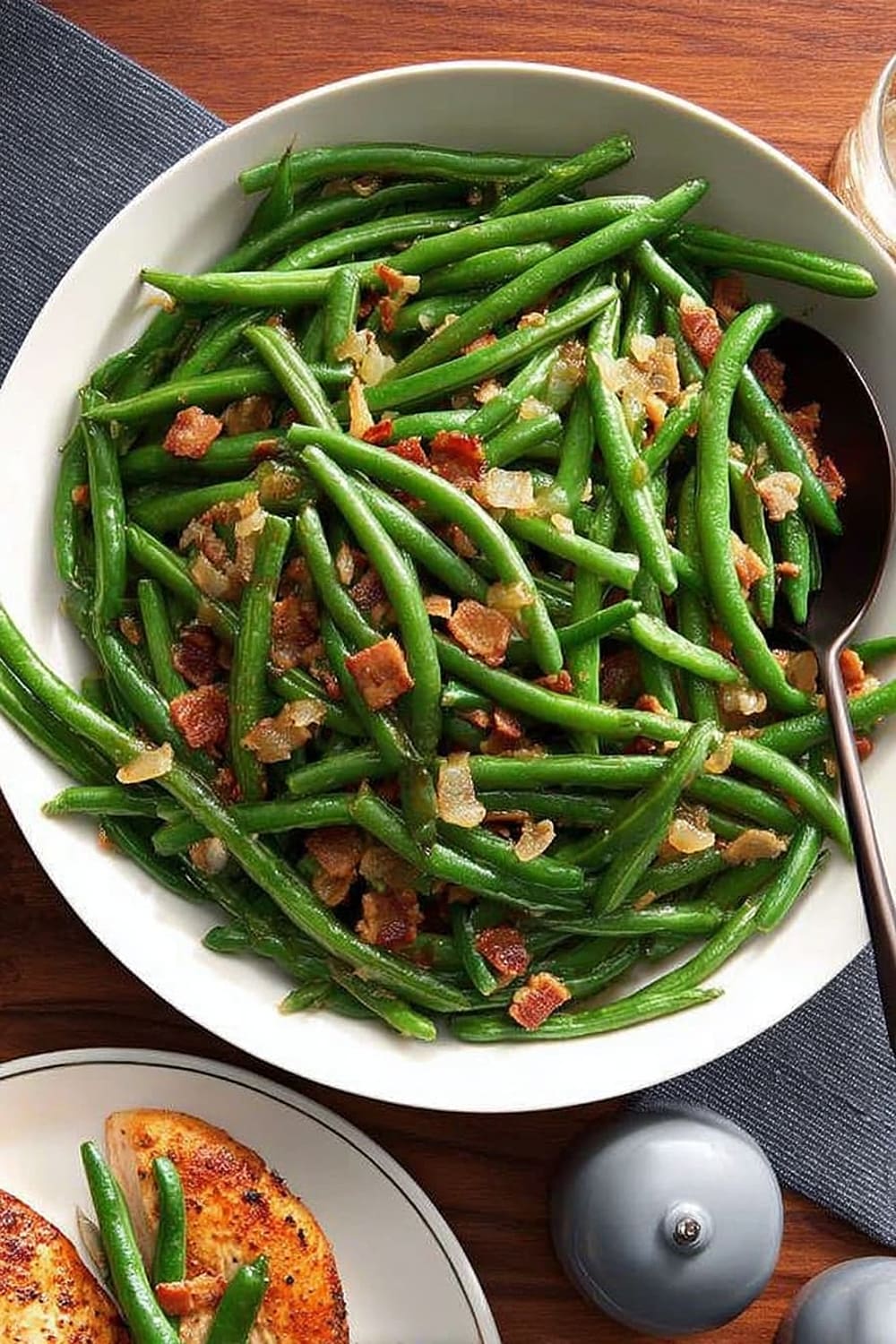
Make It Diabetes-Friendly
Carb Content Analysis:
- Current carbs per serving: Approximately 8-10 grams, primarily from green beans
- Natural fiber content: 4-5 grams per serving helps slow glucose absorption
- Glycemic impact: Low due to high fiber and protein from bacon
Portion Control Strategies:
- Recommended serving size: 1 cup provides balanced nutrition without carb overload
- Protein pairing: The bacon provides 6-8 grams protein, helping stabilize blood sugar response
- Timing considerations: Ideal as side dish with lean protein main course
Blood Sugar Management Tips:
- Fiber advantage: Green beans’ natural fiber slows carbohydrate absorption
- Fat content benefit: Bacon fat helps slow gastric emptying, reducing glucose spikes
- Meal composition: Pair with grilled chicken or fish for complete diabetes-friendly meal
Enhanced Modifications:
- Extra vegetables: Add bell peppers or mushrooms to increase volume without significantly increasing carbs
- Herb seasoning: Use fresh herbs instead of salt to enhance flavor without affecting blood sugar
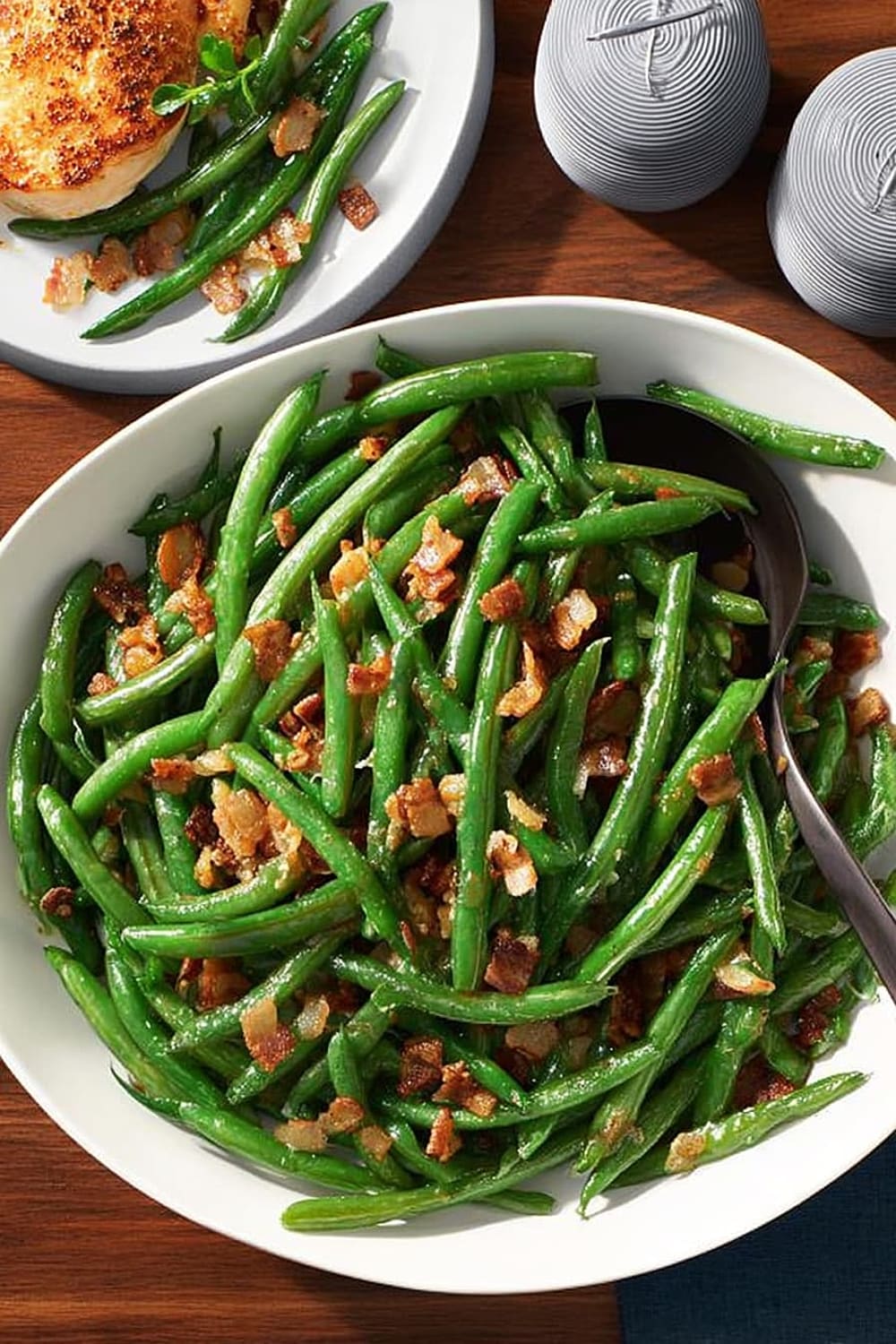
Perfect Pairing Suggestions
Protein Main Courses
This bacon-enhanced side dish pairs beautifully with grilled chicken breast or pork tenderloin, where the smoky bacon flavors complement rather than compete with the main protein. Baked salmon creates an elegant combination, with the green beans’ crisp texture contrasting the fish’s flaky richness. For holiday meals, serve alongside roast turkey or glazed ham, where the bacon adds depth without overwhelming the centerpiece.
Beverage Pairings
A crisp Sauvignon Blanc or Pinot Grigio cuts through the bacon’s richness while highlighting the green beans’ fresh flavor. For red wine lovers, a light Pinot Noir complements the smoky elements without overpowering the vegetables. Belgian wheat beer or pilsner provides refreshing contrast to the dish’s savory richness.
Complete Meal Ideas
Build a Southern-inspired menu with cornbread and mashed sweet potatoes for comfort food appeal. For lighter fare, pair with quinoa pilaf and roasted root vegetables for a balanced, nutritious plate. During summer entertaining, serve alongside grilled corn and tomato salad for a fresh, seasonal combination.
Seasonal Occasions
Perfect for Thanksgiving as a twist on traditional green bean casserole, or Easter dinner where the fresh green color adds visual appeal to the holiday table.
Pro Tips and Troubleshooting
Achieving Perfect Texture
Don’t overcook the green beans during the initial boiling phase – they should still have a slight snap when you bite them, as they’ll continue cooking briefly when tossed with the hot bacon mixture. Test for doneness by fishing out a bean with tongs and tasting it rather than relying solely on timing.
Bacon Rendering Secrets
Start the bacon in a cold pan rather than preheating it, which allows the fat to render slowly and evenly without burning the meat. If your bacon seems to be browning too quickly, reduce the heat to medium-low and be patient – properly rendered bacon fat is key to coating every bean.
Storage and Reheating
Store leftovers in the refrigerator for up to 3 days in an airtight container. Reheat in a skillet over medium heat rather than the microwave to maintain the beans’ texture and re-crisp the bacon. Add a splash of water if the mixture seems dry during reheating.
Make-Ahead Strategy
You can blanch the green beans up to a day ahead – just plunge them into ice water immediately after cooking to stop the cooking process, then store in the refrigerator. When ready to serve, proceed with the bacon and onion step, then add the pre-cooked beans for just 1-2 minutes to heat through.
This recipe proves that sometimes the simplest combinations create the most satisfying results, turning everyday ingredients into something that feels both comforting and special enough for any occasion.